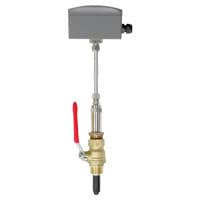
You arrive at a large field, small sprouts peeking out of the soil. At the center of the field lies a structure connected to a span of pipe from which sprinklers hang. Trusses brace and support its weight. From the air, this field would appear to be a perfectly circular patch of green.
Center pivot irrigation systems are one of many ways to distribute water to crops. As its name suggests, this method involves rotating around a central pivot point. When the machine rotates, it releases water from the sprinklers and irrigates crops. (Agrivi.com) By using this system, farmers can ensure a uniform application of water across an entire field.
In order to make certain the irrigation system is running properly, it is important to use both pressure and flow transmitters.

Pressure transmitters, such as the Series 626 & 628, are used to monitor irrigation system pressure. It is necessary that pressure be neither too low nor too high. “Insufficient pressure can impact application uniformity by preventing adequate water from reaching the far end of the pivot; whereas, excessive pressure may provide good uniformity but inflates energy costs.” (cropwatch) In the case of a leak or pressure inconsistencies due to elevation, pressure transmitters may provide early detection for farmers to resolve issues early in the growing season.
 Industrial Pressure Transmitters, Series 626 and 628
Industrial Pressure Transmitters, Series 626 and 628The Series 626 & 628transmitters are built for use in harsh environments. They are compact, rugged sensors with both shock and vibration resistance. The 626 & 628 are ideal for applications like center pivot irrigation systems, where electrostatic dischargeis present. They're also well protected from surges that might arise due to nearby lightning strikes.
Flow transmitters, such as theSeries IEF, are used to measure fluid velocity in the irrigation system.
In a system that uses a radial pipe, water travels in a straight line down the field, with all nozzles covering the same area and having the same flow rate. Hence, the pivot system provides a high degree of uniformity of applied water. Since sprinklers near the pivot cover less area, their water flow rates are less than those located near the end of the pivot, where each sprinkler covers a much larger area. (Agrivi.com)
 Insertion Electromagnetic Flow Transmitter, Series IEF
Insertion Electromagnetic Flow Transmitter, Series IEFThe IEF insertion electromagnetic flow transmitter is NSF certified with a NEMA 6P (IP68) rating. It is hot-tap valve capable, which means that the transmitter can be installed or maintained without shutting down the entire system. Standard accuracy units fit pipe sizes from 4 to 36” and are easily installed via a field configurable display.
DwyerOmega also offers several level transmittersthat can be used to monitor tanks of fertilizer at the pivot point. When selecting a transmitter for your tank, be sure to check the chemical compatibility of the fertilizer with the wetted materials of the transmitter.
Level transmitters can also be used at the reservoir or pump site which supplies water to the system. The Series PBLT2/PBLTXhas a durable cage design which helps to protect it from sediment and other floating solids. It incorporates lightning and surge protection utilizing dual arrestor technology, grounded to the case.
DwyerOmega® instrumentation can help achieve an even flow rate for uniform application of water to increase crop yields. If you have any questions about selecting products for your application, the DwyerOmega Applications Engineers are available to assist by phone at (219) 879-8868 x6402, or by email at tech@DwyerOmegamail.com.

